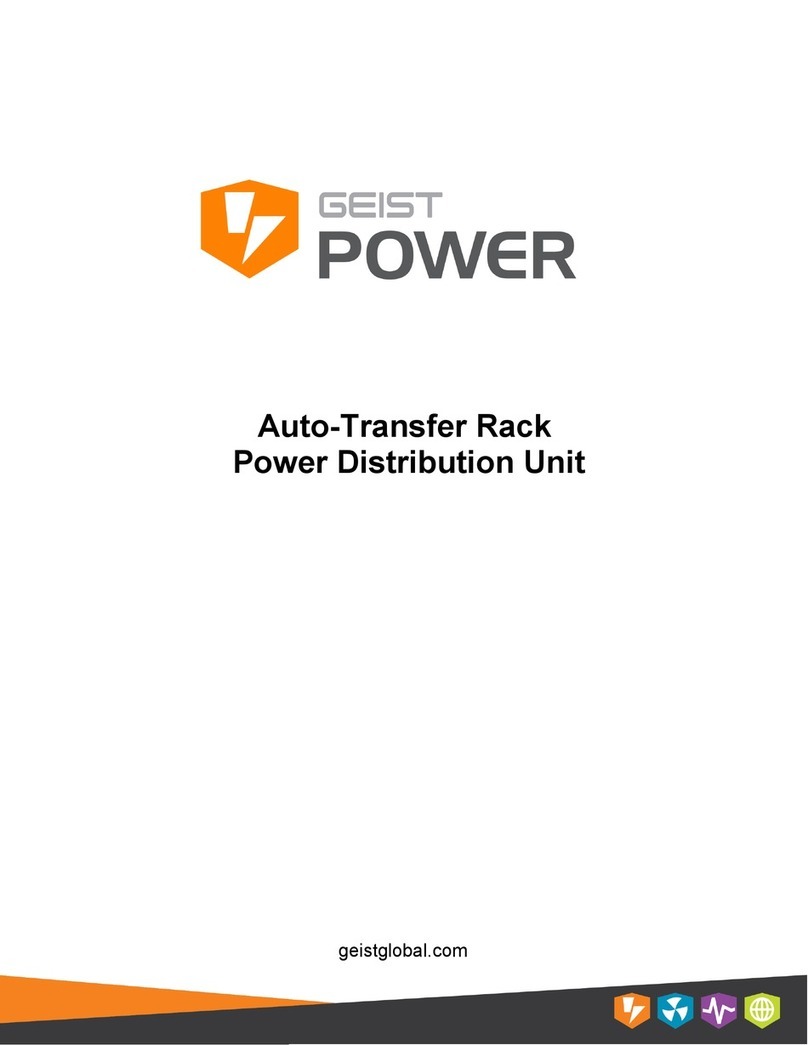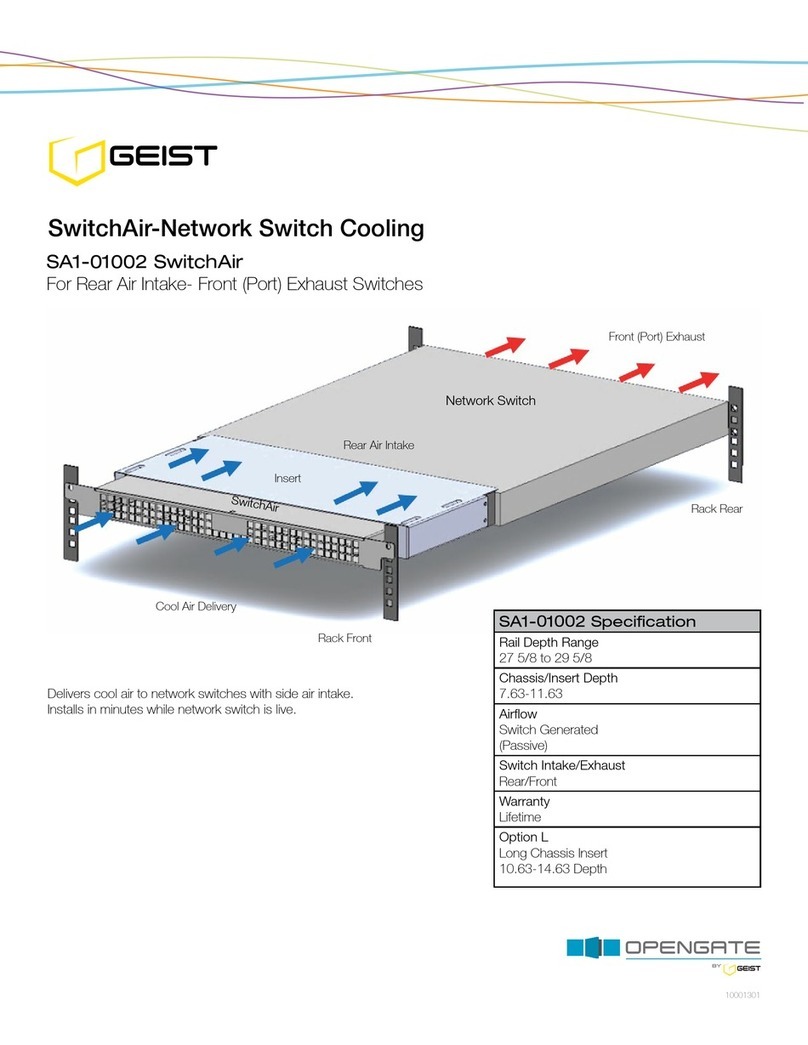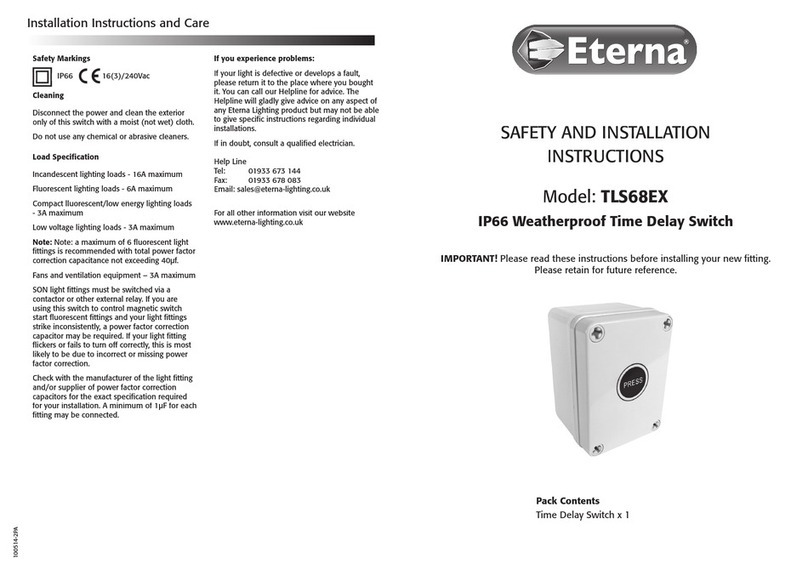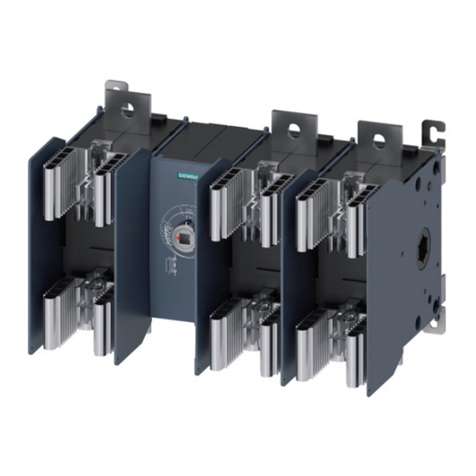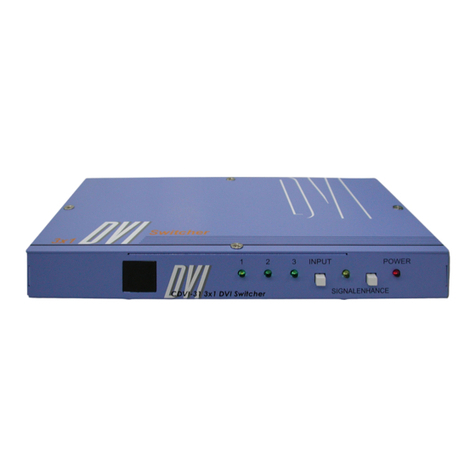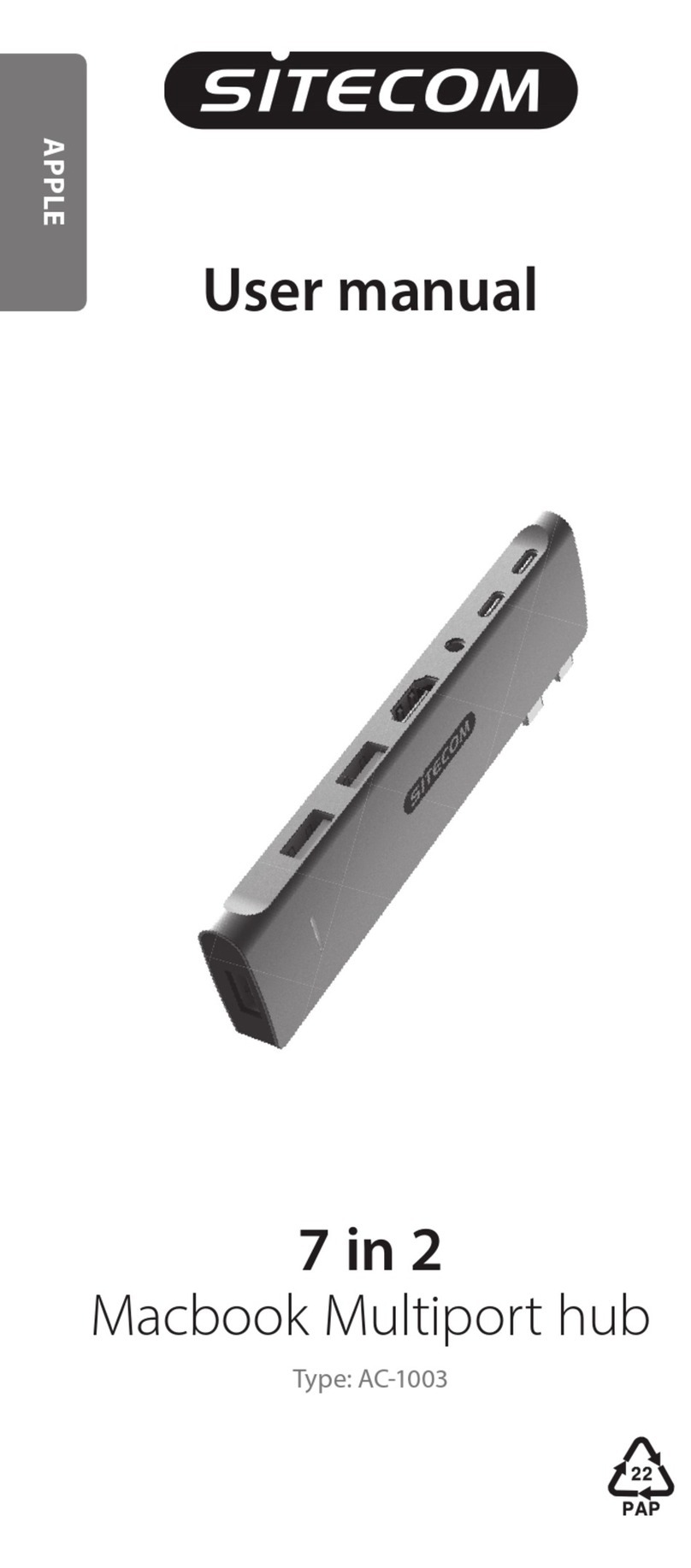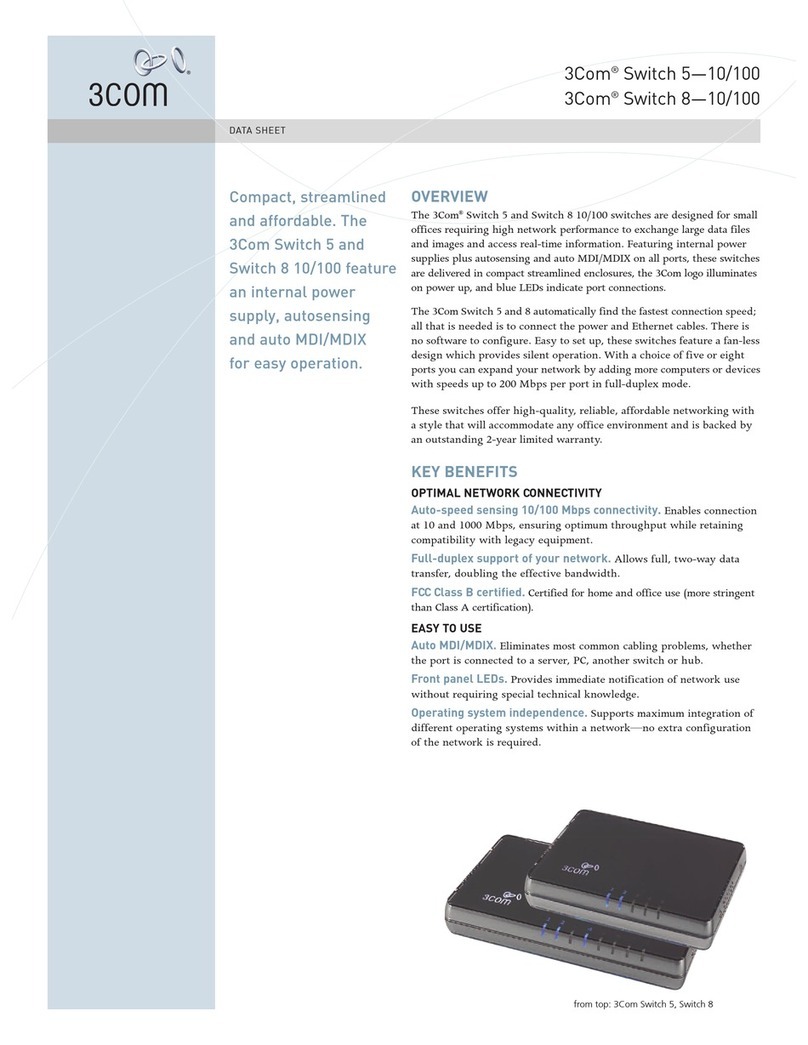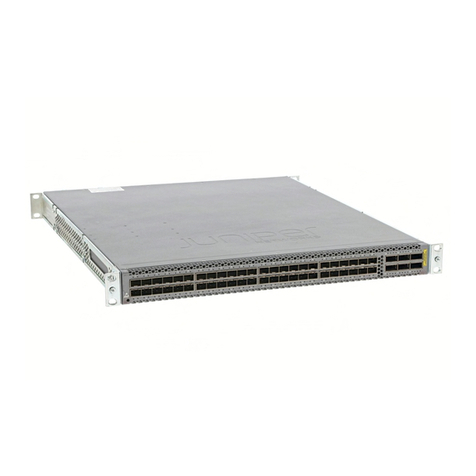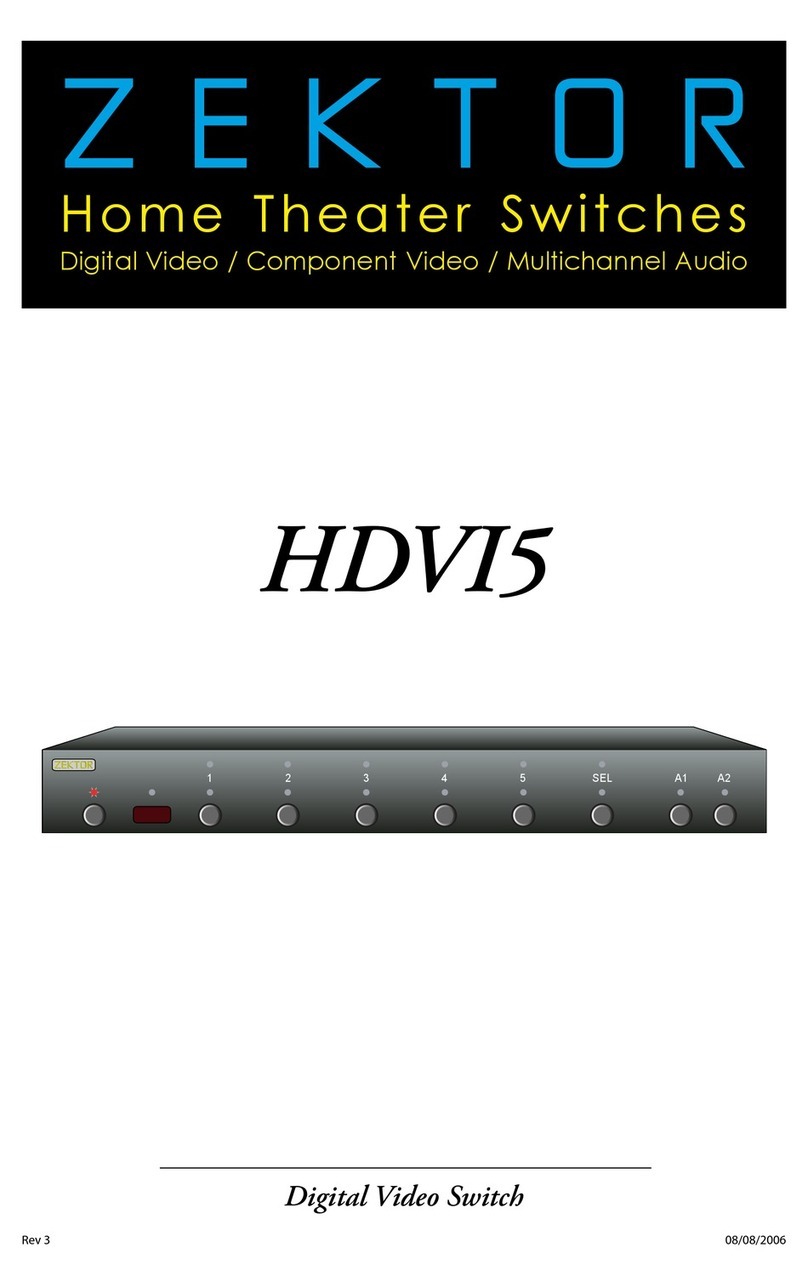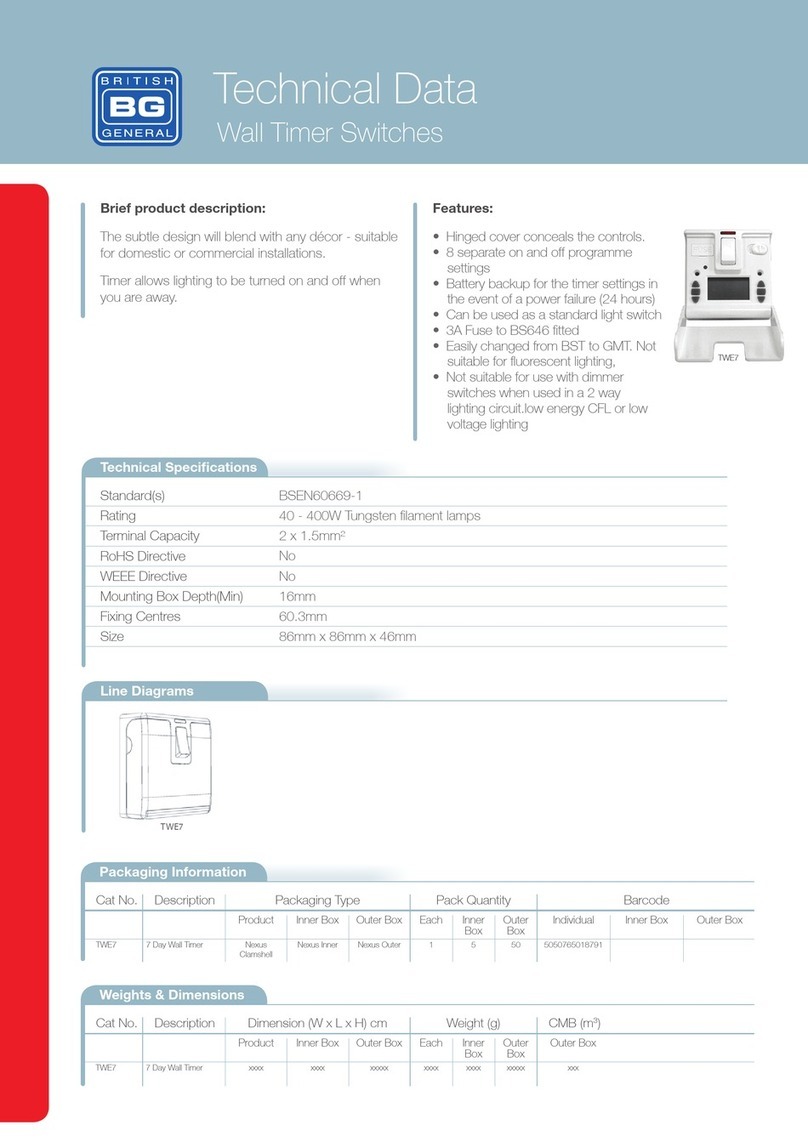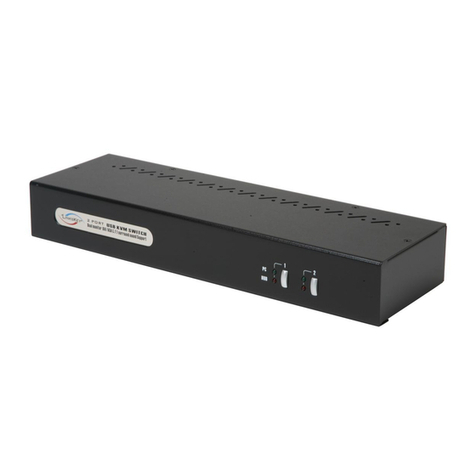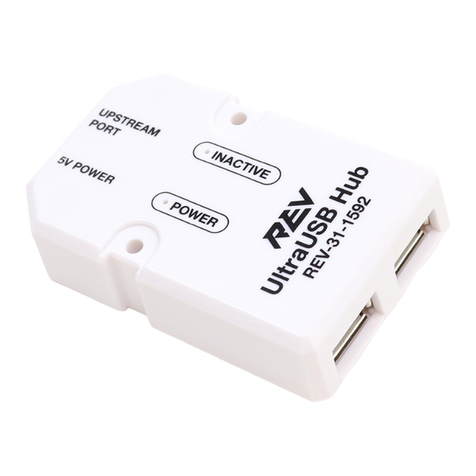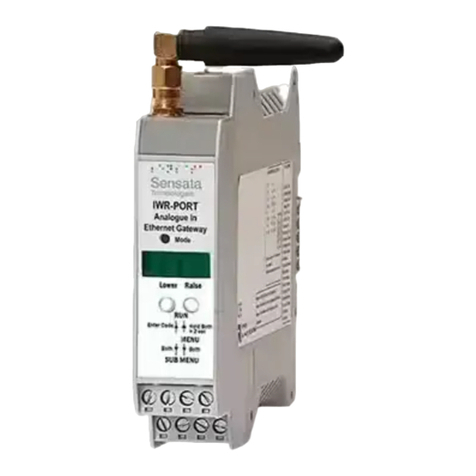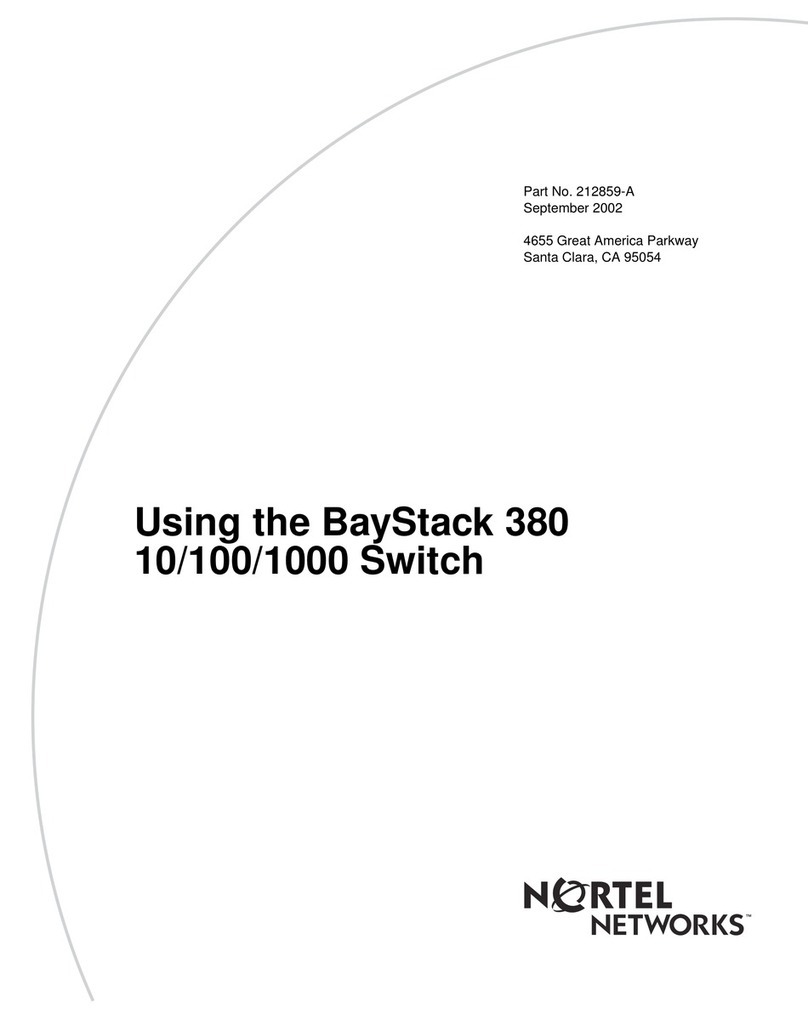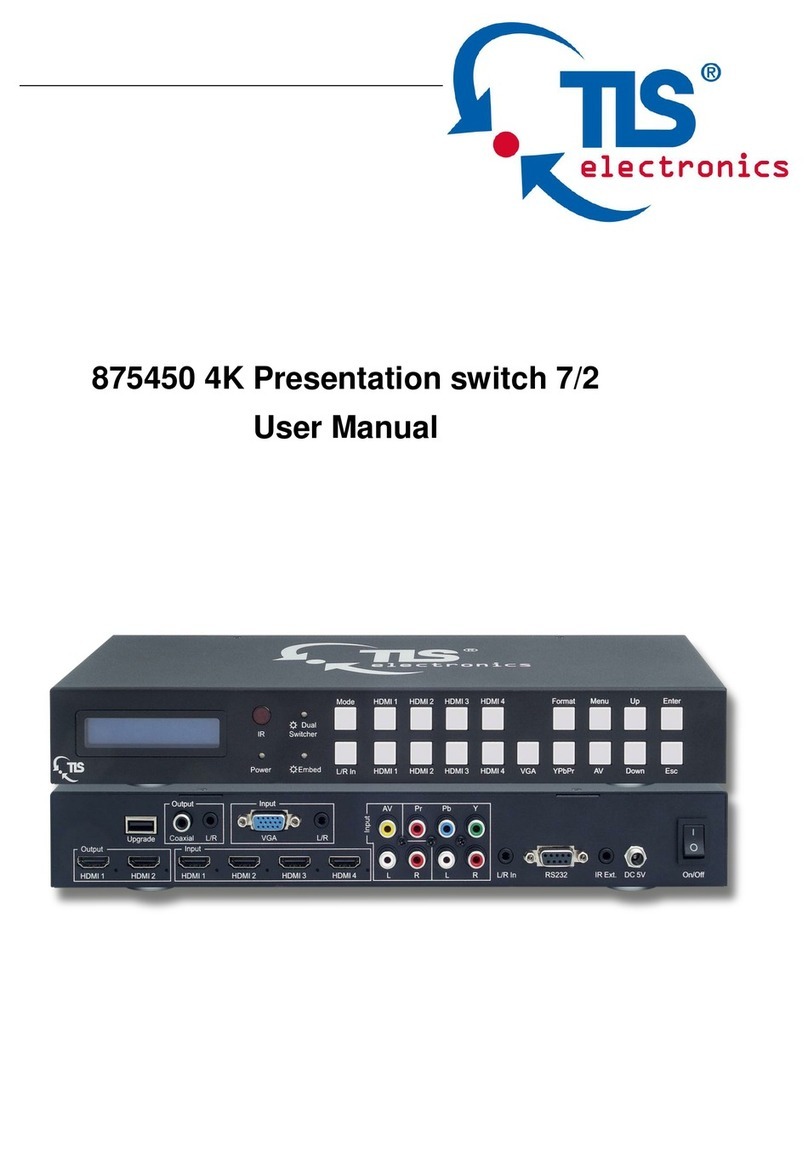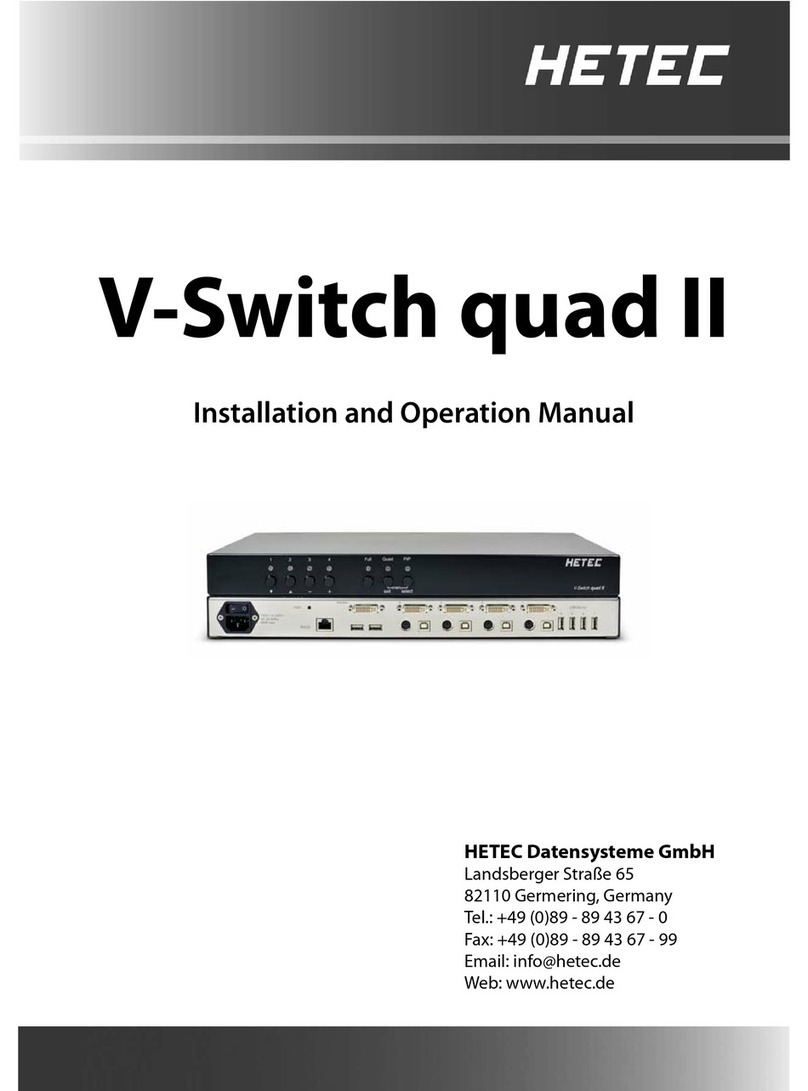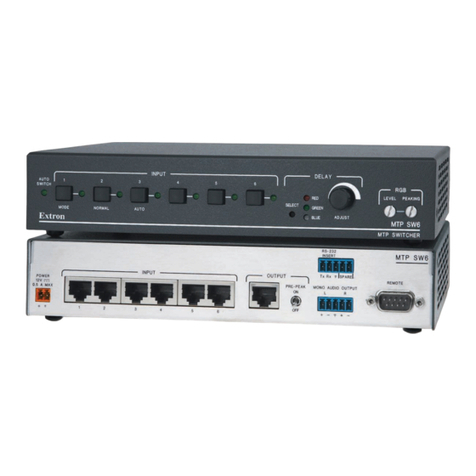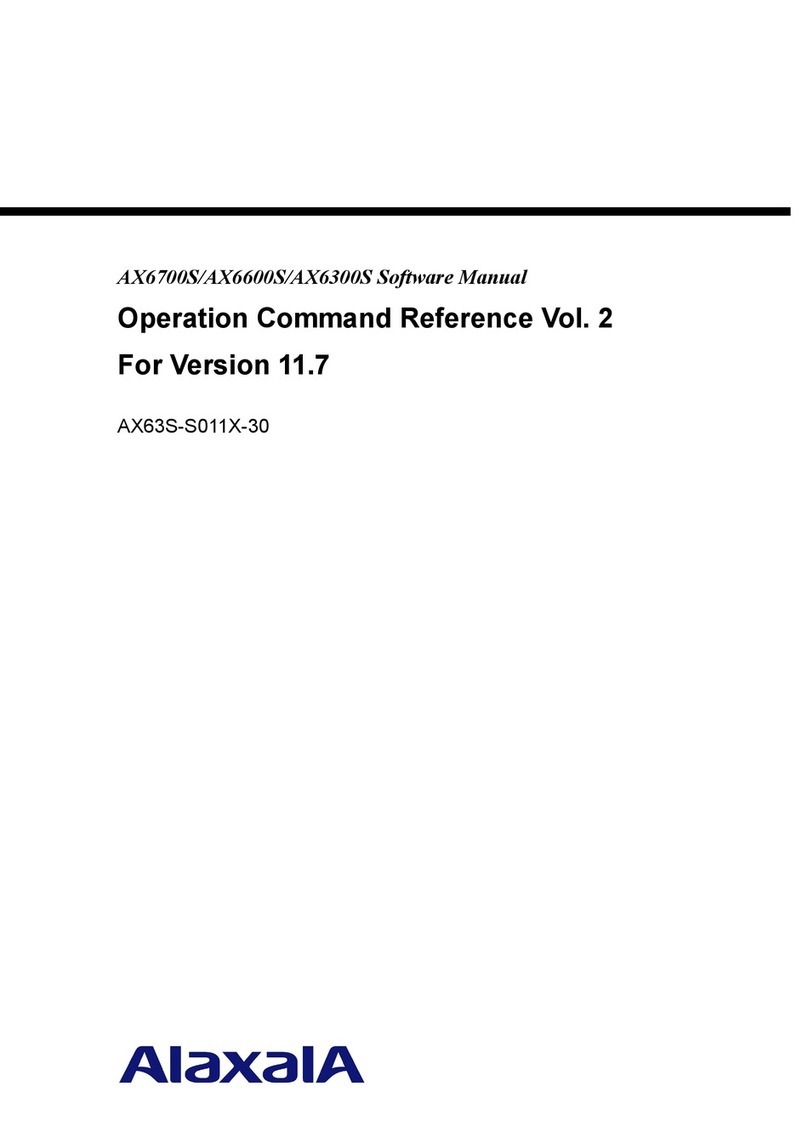Geist RS2 Series User manual

Geist Manufacturing 1821 Yolande Ave., Lincoln, NE 68521
800.432.3219 | 402.474.3400 | F: 402.474.4369 | www.geistmfg.com
Instruction Manual
Satellite Switched
Power Monitoring Unit
RS2 Series

GM1104
2
Revision Date: 8/24/2011
Contents
Contents............................................................................................................................2
Specifications....................................................................................................................3
Overview 3
Environmental 3
Electrical 3
Receptacle Ratings 3
EMC Verification 3
Installation .......................................................................................................................5
Guidelines 5
Mounting 5
Web Interface ...................................................................................................................7
Overview 7
Sensors Page 7
Logging Page 8
Display Page 9
Alarms Page 10
Sensors ...........................................................................................................................11
Overview 12
Internal Sensors 12
Data Logging and Display 12
Service and Maintenance 12
More Technical Support 12
Table of Figures ..............................................................................................................13
Revision History ..............................................................................................................14

GM1104
3
Revision Date: 8/24/2011
Specifications
Overview
The RS2 Series expands the power of your Geist R-Series RSMINI, RSE, RSO, RCX, RSM, RCM,
or RCU units (firmware version 3.00 and higher ONLY) with the addition of 2 outlets with
remote switching and monitoring. RS2 Series units use the host unit’s built in web server to
display power monitoring data and give users control for installations needing switching of
either one or two outlets. No software other than a web browser is required for operation and
several data formats are available. RS2 Series units monitor Voltage, Current, Real and
Apparent Power, and also provide a calculated Power Factor. The measurements are per unit,
so both outlets are measured as one circuit. A single, Ethernet equipped host can connect
multiple units within a cabinet or row by tethering units. Optional external sensors can monitor
other environment factors.
Note: On boot-up the RS2 will only turn on Outlet 1. After the RS2 has completed boot-up
(about 5 seconds) Outlet 2 will turn on. This is to prevent a large inrush current if the RS2 is
supplying power to certain devices.
Environmental
Temperature
Operating: 10°C (50°F) min 45°C (104°F) max
Storage: -25°C (-13°F) min 65°C (149°F) max
Humidity
Operating: 5% min 95% max (non-condensing)
Storage: 5% min 95% max (non-condensing)
Elevation
Operating: 0 m (0 ft) min 2000 m (6561 ft) max
Storage: 0 m (0 ft) min 15240 m (50000 ft) max
Electrical
See nameplate for unit ratings.
Receptacle Ratings
NEMA 5-15R 125 Volts, 15 Amp
IEC-320 C13 125/250 Volt, 15 Amp (North America) or 10 Amp (Global)1
IEC-320 C19 125/250 Volt, 20 Amp (North America) or 16 Amp (Global)
EMC Verification
This Class A device complies with part 15 of the FCC Rules. Operation is subject to the
following two conditions: (1) This device may not cause harmful interference, and (2) this
device must accept any interference received, including interference that may cause undesired
operation.
1Given ratings are per receptacle bank

GM1104
4
Revision Date: 8/24/2011
This Class A digital apparatus complies with Canadian ICES-003.
Cet appareil numérique de la classe A est conforme à la norme NMB-003 du Canada.
Warning: Changes or modifications to this unit not expressly approved by the party responsible
for compliance could void the user’s authority to operate this equipment.

GM1104
5
Revision Date: 8/24/2011
Installation
Guidelines
•Each host unit can support up to 16 attached sensors including RS2 units.
•Each host can support up to 600 feet of aggregate sensor cable length connecting the RS2
units, and other sensors, to the host.
•RS2 units are ONLY supported by Geist R-Series units with firmware version 3.00 or higher.
•If the RS2 is installed in a cabinet the ambient temperature of the rack should be no greater
than 45°C.
•Install the RS2 such that the amount of airflow required for safe operation of equipment is
not compromised.
•Mount the RS2 so that a hazardous condition is not achieved due to uneven mechanical
loading.
•Follow nameplate ratings when connecting equipment to the branch circuit. Take into
consideration the effect that overloading of the circuits might have on over-current
protection and supply wiring.
•The RS2 relies on the building installation for protection from over-current conditions. A
Listed circuit breaker is required within the building installation. The circuit breaker should
be sized according to the RS2’s nameplate ratings and local/national electrical codes.
•Reliable earth grounding of rack-mount equipment should be maintained. Particular
attention should be given to supply connections other than direct connections to the branch
circuit. The RS2 must be connected to an earthed socket-outlet.
•For pluggable equipment, install the RS2 so that the input plug or appliance coupler may be
disconnected for service.
•Sequential power-up of devices powered by the RS2 is recommended to avoid high inrush
current.
•Caution: Disconnect all power cords before servicing.
Mounting
The RS2 is made to be mounted to any flat surface using four (4) screws, as shown in Figure 2.
The mounting holes are 1/4” diameter, so screws should be selected to fit and strong enough to
securely hold the RS2 in place. The mounting hole dimensions are shown in Figure 1.
Figure 1: RS2 mounting hole dimensions

GM1104
6
Revision Date: 8/24/2011
Figure 2: Mounting the RS2

GM1104
7
Revision Date: 8/24/2011
Web Interface
Overview
The RS2 must be attached to a host unit via RJ-12 patch cable in order to view the RS2 on a
network. The host unit is accessible via a standard, unencrypted HTTP connection as well as an
encrypted HTTPS (SSL) connection. The following web pages change or contain added content
after the RS2 Series unit is connected:
Sensors Page
The front page, Sensors, gives both instantaneous and historical views of the host unit’s data.
Real time readings are provided for all power strip and sensor data next to historical graphs.
Each attached RS2 Series units will show a remote sensor section on the host unit’s Sensors
page. All power monitoring information will be shown here.
Figure 3: Sensors Page - Remote Sensor

GM1104
8
Revision Date: 8/24/2011
Logging Page
The host unit’s Logging page allows the user to access the historical data of the RS2 by
selecting the desired readings and time range to be graphed. This is done the same way the
sensor readings are graphed on the host unit. A new section will be shown for each RS2 added
to the host unit.
Figure 4: Logging Page

GM1104
9
Revision Date: 8/24/2011
Display Page
The host unit’s Display page allows the user to assign friendly names to the RS2 unit. This
friendly name is shown as the name of the RS2 on the host unit’s other pages.This feature is
helpful to distinguish one RS2 from another RS2 or from another sensor when attached to the
same host device.
Figure 5: Display Page

GM1104
10
Revision Date: 8/24/2011
Alarms Page
The host unit’s Alarms page allows the user to establish alarm conditions for each sensor
reading. Alarm conditions can be established with either high or low trip thresholds.
To set an alarm, select the alarm type from the dropdown menu. Then select whether the
alarm will trip above or below the threshold. Finally, set the threshold limit in the text box.
If a notification is required, select the amount of time the alarm must be tripped before sending
the notification and how often to repeat the notification. Then check the boxes for the desired
notification types.
Alarm notification options differ with each host but include a buzzer, e-mail and SNMP Trap.
The RS2 adds the option of switching each outlet off or on when an alarm is tripped. Select the
outlet that is desired to be switched and then go to the Control page to select the action to be
taken. When an alarm is triggered the outlet will perform the selected action.
Note: To enable alarm switching the user must read and accept the disclaimer located on the
Config page’s Admin tab.
Figure 6: Alarms Page

GM1104
11
Revision Date: 8/24/2011
Control Page
The host unit’s Control pages will become active after the RS2 is attached, if they are not
already. The Control pages include an Actions tab and a Settings tab. The Settings tab gives
the user the ability reset the kilowatt hours or to change the friendly names of the outlets on
the RS2. The Actions tab contains the controls for the switching capabilities of the RS2. There
are six options for switching the outlet:
•Manual off – Turns off outlet.
•Manual on – Turns on outlet.
•Alarm trips off – Sets outlet to be turned off when alarm trips. Outlet will be on
whenever the alarm is untripped.
•Alarm trips off, latching – Sets outlet to be turned off when alarm trips. The outlet
stays off until the “Release to ON” control button is pressed, even if the alarm is cleared.
•Alarm trips on – Sets outlet to be turned on when alarm trips. Outlet will be off
whenever the alarm is untripped.
•Alarm trips on, latching – Sets outlet to be turned on when alarm trips. The outlet
stays on until the “Release to OFF” control button is pressed, even if the alarm is
cleared.
Figure 7: Control Actions Page
Figure 8: Control Settings Page
Sensors

GM1104
12
Revision Date: 8/24/2011
Overview
The RS2 updates its measurements every 5 seconds. Like all external sensors, the RS2’s
measurements are read by the host every 10 to 30 seconds, depending on the number of other
sensors connected. Sensor data collected by the RS2 gives useful trend analysis data, and
allows users to view changes and draw useful conclusions about what is happening over time in
the monitored environment.
Internal Sensors
The RS2 contains the following onboard sensors:
•Volts: Measures instantaneous RMS voltage.
•Volts(Peak): Measures the highest reported voltage since the last time the data was
updated, typically every 5 seconds.
•Amps: Measures instantaneous RMS current.
•Amps(Peak): Measures the highest reported current since the last time the data on the
screen was updated, typically every 5 seconds.
•Real Power:Average of instantaneous voltage and current over the last 1.5 seconds.
•Apparent Power:The product of instantaneous RMS Voltage and RMS Current. This is the
value used by circuit breakers.
•Power Factor:The ratio of Real Power to Apparent Power.
Data Logging and Display
All data collected by the RS2 can be graphed by the host unit. The host unit’s Logging page
allows the user to select graphed content to be logged. Selected sensor values are logged by
the host unit at a rate of one point per minute and are shown on the Sensors page. Host units
with LCD displays can optionally show sensor measurements there as well. The number of
selected sensors determines the maximum data logging time span. This period is calculated
and displayed on the Logging page. The oldest data will be deleted when the onboard memory
fills up in order to make room for new data. All RS2 sensor values are shown on the RS2’s
onboard display.
Service and Maintenance
No service or maintenance is required. Do not attempt to open the RS2 or you may void the
warranty. No serviceable parts inside. It is recommended that power be removed from the
unit before installing or removing any equipment.
More Technical Support
http://www.geistmfg.com
(800) 432-3219
Email: support@geistmfg.com
Or contact your distributor.

GM1104
13
Revision Date: 8/24/2011
Table of Figures
Figure 1: RS2 mounting hole dimensions ................................................................................5
Figure 2: Mounting the RS2...................................................................................................6
Figure 3: Sensors Page - Remote Sensor.................................................................................7
Figure 4: Logging Page .........................................................................................................8
Figure 5: Display Page..........................................................................................................9
Figure 6: Alarms Page ........................................................................................................10
Figure 7: Control Actions Page.............................................................................................11
Figure 8: Control Settings Page............................................................................................11

GM1104
14
Revision Date: 8/24/2011
Revision History
Revision
Date
Notes
Approved By
1.0
3/22/2011
Initial Version
CDG, AK, BP
1.1
8/16/2011
Alarms outlet control features added
CDG
Table of contents
Other Geist Switch manuals
